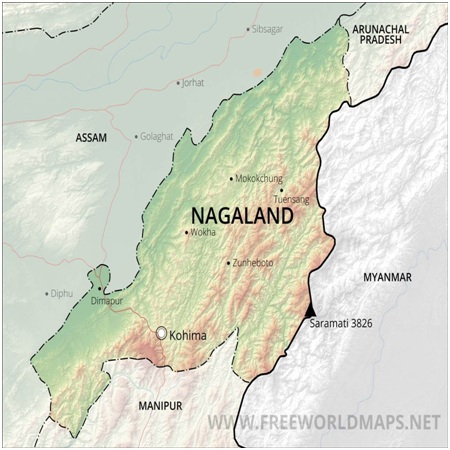

Context
The 2015 Framework Agreement between the Centre and the National Socialist Council of Nagalim (Isak-Muivah) to finalise the Naga Peace Accord is now turning out to be the key stumbling block in reaching an agreement between the two sides and finding a permanent solution to the longstanding Naga issue.
Background
- The government has been negotiating with
- National Socialist Council of Nagaland (IM), the most prominent Naga group fighting the Indian state since the 1970s
- Naga National Political Groups (NNPG), an umbrella of about seven outfits
- The Indian state has been negotiating with Naga rebels since 1997 but reached a breakthrough in 2015 when they signed a framework agreement with NSCN (IM) and another agreement with NNPG in 2017.
- But no final arrangement has been reached till now.
Analysis
The bone of contention
- The Naga conflict is rooted in the year-old Naga Nationalism, according to which many Naga groups demanded an independent Nagaland.
- Declaration of independent Nagaland: On August 14 1947, Naga National Council NCC led by Angami Zapu declared independent Nagaland.
- Establishment of Naga Army: In 1952, Zapu established the Naga Federal Government and Naga Federal Army.
- AFSPA: This was met with a military response by the Indian state and AFSPA was enacted in the region.
- Shillong Accord: In the 1970s, dialogue was initiated to resolve the issue and in 1976 the Shillong Accord was signed.
- However, the accord was rejected by prominent NNC leaders, since they were not ready to accept complete Indian sovereignty.
- In the early 1980s top Naga Leaders like Isak Chishi Swu, Thuingaleng Muivah, S S Khaplang left NNC and formed the National Socialist Council of Nagaland NSCN.
|
The State Profile
|
The 2015 Agreement
- Naga Leaders like Isak Chishi Swu, Thuingaleng Muivah, S S Khaplang left NNC and formed the National Socialist Council of Nagaland (NSCN).
- Their aim was to establish a sovereign Naga state.
- In 1988 the group split into two
- NSCN (IM) led by Muivah and Isak
- NSCN(K) led by Khaplang
- After many rounds of talk, the group signed a framework agreement for the Naga Peace Accord in August 2015.
What are the roadblocks in the peace process?
- Adamant demands: The Naga leaders seem adamant about their demands. These demands appear to be the roadblock in the peace process. The NSCN (IM) in particular remained adamant on its stance of:
- shared sovereignty
- greater Nagalim i.e stretching the borders beyond the state of Nagaland
- a separate constitution and separate flag
- Different views on interpretation: It is said that both sides differed on the interpretation of the framework agreement.
|
Involved groups Currently, groupings like the NNPG—which includes outfits like the Federal Government of Nagaland and the Naga Nationalist Council—and NSCN-K, along with NSCN-IM, are involved in the peace talks. |
Why issues are still persistent in Nagaland?
- Support from locals: Ethnic identity has been critical in sustaining armed movements in the region and even within individual states. The local population often supports militant groups because they are seen as protectors of the ethnic identity.
- Taking advantage of agreement: A large number of armed groups are now in ceasefire agreements with the government. This has helped reduce violence, but there has also been a downside because of the very generous terms of some of the agreements.
- As an example, the NSCN (IM) has been permitted to establish camps in Nagaland and Manipur where they carry arms and almost run a parallel government. The Suspension of Operations (SoO) agreement with the Kuki groups in Manipur, now 16 years old, has created exclusive camps for them, and the government pays a stipend for each member of the group.
- Some groups under ceasefire have taken advantage of the agreements to continue with fundraising and extortion, often with greater impunity because they feel they are now shielded from government actions.
|
Violence in Northeastern India Insurgency-related violence in the Northeastern states has significantly declined since its peak in the 2008-09 period. According to data from the South Asian Terrorism Portal, insurgency-related deaths in Assam, Nagaland and Manipur have decreased from 1,070 in 2008 to 17 in 2020. However, as is often the case in internal conflicts, the absence of violence is not an automatic indicator of normalcy. |
What are the pathways to resolve conflicts?
- Assimilation: There is need for assimilation by stressing that an emphasis on ethnic identity weakens the idea of a cohesive nation that should serve as the primary ideological beacon.
- Empowerment, reconciliation and autonomy: There could also be accommodation of diversity by meeting the aspirations of different groups through political empowerment, reconciliation and grant of autonomy.
- Cultural understanding: An understanding of cultures and identity and their role in promoting conflicts in the region must be at the heart of finding ways to bring lasting peace.
Conclusion
At present, the ball is the government's court. The various Naga groups seem to be united in their demand that what has been committed in the framework agreement should be taken to its logical conclusion.



